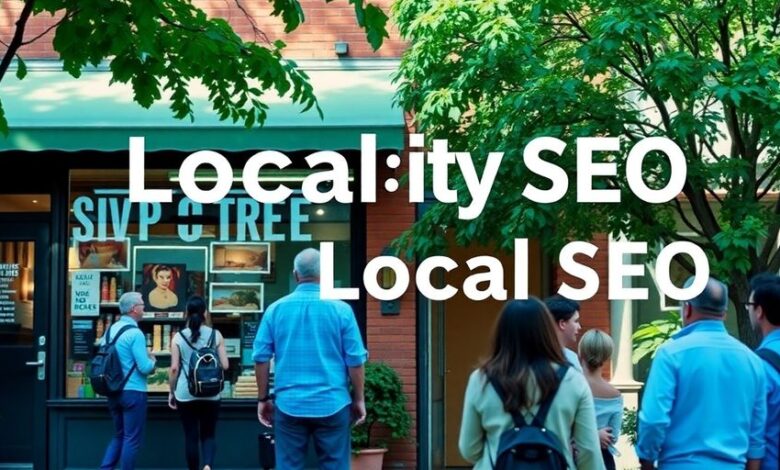Mastering Local SEO: Strategies for Boosting Your Business Visibility in the Community

In today’s digital age, mastering Local SEO is essential for any business wanting to stand out in its community. Local SEO focuses on optimizing your online presence to attract more customers from relevant local searches. This means getting your business noticed by people who are searching for your services nearby. With the right strategies, you can boost your business visibility in the community and connect with potential customers right when they need you.
Key Takeaways
- Local SEO is crucial for attracting nearby customers to your business.
- Claim and optimize your Google Business Profile to improve visibility.
- Incorporate local keywords into your website content and metadata.
- Encourage customer reviews and actively respond to them.
- Stay updated with local SEO trends and adapt your strategies accordingly.
Understanding The Basics Of Local SEO

Defining Local SEO
Okay, so what is local SEO? Basically, it’s about making sure your business shows up when people in your area search for what you offer. Think of it as optimizing your online presence to attract customers nearby. It’s not just about ranking high; it’s about ranking high for the right people. This means focusing on specific strategies to boost your visibility in local search results. This includes things like optimizing your Google Business Profile, getting local backlinks, and making sure your business info is consistent everywhere online.
Importance Of Local SEO For Small Businesses
If you’re a small business owner, local SEO is super important. I mean, really important. Why? Because most people looking for local services or products use search engines to find them. If you’re not showing up in those local searches, you’re missing out on potential customers. A strong local SEO presence can help you:
- Increase your visibility to people actively searching in your area.
- Build trust with potential customers through reviews and accurate information.
- Drive more traffic to your website and physical store.
- Ultimately, boost your sales and grow your business.
Ignoring local SEO is like ignoring a big chunk of your potential revenue. It’s about being found by the right people at the right time, when they’re ready to buy.
Key Differences Between Local SEO And General SEO
So, how is local SEO different from regular SEO? Well, general SEO aims to improve your website’s ranking across a wider area, maybe even globally. It’s great for online businesses that serve a broad audience. Local SEO, on the other hand, is all about targeting a specific geographic area. It’s about capturing that local search territory and attracting nearby customers. The tactics are different too. Local SEO puts a big emphasis on things like local citations, Google Business Profile optimization, and local keywords. General SEO focuses more on broader keyword strategies and content marketing for a wider audience.
Optimizing Your Google Business Profile
Your Google Business Profile (GBP) is often the first impression potential customers have of your business online. It’s super important to make it count. Think of it as your digital storefront – you want it to be inviting, informative, and easy to navigate. A well-optimized GBP can significantly boost your visibility in local search results and drive more foot traffic (or clicks!) to your business. Let’s get into how to make your GBP shine.
Claiming Your Business Listing
First things first, you need to claim your business listing on Google. If you haven’t already, head over to Google Business Profile and follow the steps to verify your business. This usually involves receiving a postcard with a verification code at your business address. It might seem a little old-school, but it’s Google’s way of making sure you’re legit. Once you’ve claimed your listing, you have control over the information displayed to potential customers. If someone else claimed it, follow Google’s dispute process to regain control. This is a critical first step, so don’t skip it!
Completing Your Profile Information
Once you’ve claimed your listing, it’s time to fill out all the details. Don’t skimp on this! The more information you provide, the better Google can understand your business and match it with relevant searches. Here’s what you should focus on:
- Business Name: Make sure it’s exactly the same as your official business name.
- Address: Use your full, accurate address. If you serve customers at their location, you can hide your address and specify service areas.
- Phone Number: Use a local phone number if possible. This helps reinforce your local presence.
- Business Category: Choose the most relevant category for your business. You can add additional categories, but start with the most specific one.
- Business Hours: Keep your hours up-to-date, especially during holidays or special events. Nobody wants to show up to a closed business!
- Website: Link to your website. Make sure your website is mobile-friendly and easy to navigate. You can improve your SEO content creation by linking to relevant pages.
- Description: Write a compelling description of your business. Highlight what makes you unique and include relevant keywords. Don’t stuff it with keywords, though – keep it natural and engaging.
- Attributes: Select relevant attributes, such as “wheelchair accessible” or “free Wi-Fi.” This helps customers find businesses that meet their specific needs.
Completing your profile is not a one-time task. Regularly review and update your information to ensure it’s accurate and reflects any changes in your business. Google likes fresh, accurate data, and so do your customers.
Utilizing Google Posts Effectively
Google Posts are like mini-ads that appear in your business profile on Google Search and Maps. They’re a great way to share updates, promote offers, and engage with potential customers. Here are some ideas for using Google Posts:
- Announcements: Share news about your business, such as new products, services, or promotions.
- Events: Promote upcoming events, such as workshops, sales, or community gatherings. Highlighting local events can attract more customers.
- Offers: Share special deals and discounts to entice customers to visit your business.
- What’s New: Highlight recent changes or updates to your business.
When creating Google Posts, keep these tips in mind:
- Use high-quality images or videos: Visuals are key to capturing attention.
- Write concise and compelling copy: Get straight to the point and highlight the benefits of your offer.
- Include a clear call to action: Tell people what you want them to do, such as “Learn More,” “Shop Now,” or “Call Today.”
- Keep your posts fresh: Google Posts expire after seven days, so make sure to update them regularly. This shows Google that you’re actively managing your profile and provides fresh content for potential customers. You can also use Google Posts to answer frequently asked questions, further improving your local SEO optimization.
Leveraging Local Keywords For Visibility
Identifying Relevant Local Keywords
Okay, so you want people in your town to find your business online, right? It all starts with keywords. But not just any keywords – local ones. Think about what people type into Google when they’re looking for something specific in your area. “Best pizza near me,” “car repair in [your town name],” or “[your town name] coffee shops with wifi” are great examples. Brainstorm a list of these kinds of phrases. Use tools like Google Keyword Planner or even just Google Trends to see what people are actually searching for locally. Don’t forget to check out what keywords your competitors are using, too. It’s like a treasure hunt, but the treasure is visibility!
Incorporating Keywords Into Your Content
So, you’ve got your list of local keywords. Now what? You need to sprinkle them throughout your website content. But don’t just stuff them in randomly! Make sure it sounds natural and helpful to your readers. Use them in your website copy, blog posts, and even in image alt text. For example, if you own a bakery in Anytown, USA, you could write a blog post about “The Best Anytown Bakeries for Birthday Cakes.” See how that works? It’s all about being relevant and providing value to your local audience.
Using Keywords In Meta Tags And Descriptions
Meta tags and descriptions are those little snippets of text that show up in search engine results. They’re like a mini-advertisement for your website, so you want to make them count. Include your most important local keywords in your title tags and meta descriptions. This helps search engines understand what your page is about and can improve your click-through rate. Think of it as giving Google a little nudge in the right direction.
It’s important to remember that keyword stuffing can actually hurt your SEO. Focus on creating high-quality, informative content that naturally incorporates your target keywords. Search engines are smart, and they can tell when you’re trying to game the system. So, be genuine, be helpful, and be local!
Building Trust Through Customer Reviews
Reviews are super important. I mean, think about it – when you’re looking for a new place to eat or a service to use, what’s the first thing you do? You probably check out the reviews, right? It’s the same for everyone else. Good reviews build trust, and trust brings in more customers. It’s a pretty simple equation.
Encouraging Customer Feedback
Getting people to actually leave reviews can be tricky. You can’t just sit around and hope for the best. You gotta ask! But there’s a right way and a wrong way to do it. Don’t be pushy, but definitely make it easy for them. Here are a few ideas:
- Ask politely: After a sale or service, send a quick email or text asking for feedback. Keep it short and sweet.
- Make it simple: Include direct links to your Google Business Profile or other review sites. The fewer clicks, the better.
- Offer incentives (carefully): A small discount on their next purchase can work, but be careful not to violate any platform guidelines. You don’t want to buy reviews, just encourage honest feedback.
I once tried offering a free appetizer for every review at my restaurant. It worked great at first, but then people started leaving fake reviews just to get the free food. Had to shut that down real quick!
Responding To Reviews
Okay, so you’re getting reviews – awesome! But your job isn’t done. You need to respond to them, both the good and the bad. It shows you’re paying attention and that you care about what your customers think. For positive reviews, a simple “Thank you!” goes a long way. For negative ones, it’s a bit more complicated. Acknowledge the issue, apologize if necessary, and offer a solution. Don’t get defensive or argue – that just makes you look bad. Think of it as an opportunity to show off your local SEO services and commitment to customer satisfaction.
Managing Negative Reviews Effectively
Nobody likes getting a bad review, but it’s gonna happen eventually. The key is to handle it gracefully. Here’s a plan:
- Don’t panic: Take a deep breath and read the review carefully. Try to understand the customer’s perspective.
- Respond promptly: Don’t let negative reviews sit unanswered for too long. It makes it look like you don’t care.
- Be professional: Even if the customer is being unreasonable, stay calm and polite. Offer a sincere apology and a solution.
- Take it offline: If the issue is complex, offer to discuss it privately via phone or email. This can help de-escalate the situation and find a resolution.
- Learn from it: Use negative reviews as an opportunity to improve your business. Is there a recurring problem that needs to be addressed?
Remember, how you handle negative reviews says a lot about your business. Turn a bad experience into a chance to shine!
Enhancing Your Online Presence With Local Listings
Importance Of Consistent NAP Information
Having consistent NAP (Name, Address, Phone number) information is super important for local SEO. Think of it like this: if your business info is all over the place online, Google gets confused. It doesn’t know which info is correct, and that can hurt your ranking. Make sure your NAP is exactly the same on your website, Google Business Profile, Yelp, and every other online directory. It’s a small thing, but it makes a big difference. It’s like making sure all the signs point to the right place; otherwise, people get lost. You want customers to find you easily, and Google to trust that your business is legit.
Utilizing Local Directories
Local directories are like the old phone books, but online. Getting your business listed in these directories can really boost your visibility. It’s not just about being listed, though. It’s about being listed correctly and in as many relevant directories as possible. Think of sites like Yelp, Yellow Pages, and even your local Chamber of Commerce website. Each listing is like another vote of confidence for your business. Plus, many directories allow you to add photos, descriptions, and even special offers. It’s a great way to manage online reputation and attract new customers.
Benefits Of Local Backlinks
Local backlinks are links from other local websites to yours. They’re like digital referrals. Getting a backlink from a local newspaper, a community blog, or even another local business can significantly boost your SEO. It tells Google that your website is a trusted source within the community.
Here’s why they matter:
- Increased Authority: Backlinks from reputable local sites increase your website’s authority.
- Improved Ranking: Higher authority often leads to better search engine rankings.
- More Traffic: Backlinks can drive direct traffic to your website.
Think of local backlinks as word-of-mouth marketing, but for the internet. The more local sites that link to you, the more Google sees you as a relevant and trustworthy business in your area. It’s all about building those digital connections within your community.
Creating Engaging Local Content

Alright, so you’ve got your Google Business Profile looking sharp and you’re all about those local keywords. Now what? It’s time to actually connect with your community through content. Think of it as showing off your personality and proving you’re not just another faceless business. It’s about building trust and making people feel like you’re part of the neighborhood.
Developing Location-Specific Content
This is where you really show you get your local audience. Don’t just talk about your products or services in a vacuum. Talk about them in the context of where you are. For example, if you run a coffee shop, don’t just say you have great coffee. Talk about how your coffee is the perfect pick-me-up before hitting the Saturday morning farmer’s market. Or how you source your beans from a local roaster. Make it relatable. Think about what makes your town unique and weave that into your content. You could even create geo-specific landing pages for different neighborhoods if you serve a large area.
Highlighting Local Events And News
Become a local hub! Share news about community events, festivals, or even just a cool story about someone doing something awesome in town. This shows you’re invested in the area and not just trying to make a quick buck. If you’re sponsoring a local little league team, shout it from the rooftops! If there’s a charity run happening, get involved and talk about it. This kind of content makes you more than just a business; it makes you a neighbor.
Using Local Case Studies And Testimonials
Nothing builds trust like social proof. Instead of just saying you’re the best, let your customers do the talking. Feature local customers in case studies or testimonials. Ask them to share their stories about how your business has helped them. Make sure to include details that make it clear they’re local. “I love that Joe’s Pizza is just around the corner from the high school!” is way more effective than “Great pizza!” And don’t be afraid to ask for reviews! Positive reviews are a form of content that significantly influences potential customers. Encourage satisfied customers to leave reviews on various platforms and showcase these reviews on your website and social media.
Monitoring And Adapting Your Local SEO Strategy
Using Analytics To Track Performance
Alright, so you’ve put in the work, optimized your Google Business Profile, and sprinkled those keywords around. But how do you know if it’s actually working? That’s where analytics come in. Think of analytics as your local SEO report card. Tools like Google Analytics and Google Search Console are your best friends here. They give you the lowdown on website traffic, where your visitors are coming from, which pages they’re hanging out on, and what keywords they’re using to find you.
- Track your website traffic. Are more people finding you online?
- Monitor your keyword rankings. Are you showing up higher in search results for your target keywords?
- Analyze user behavior. What are people doing once they land on your site? Are they converting into customers?
Ignoring your analytics is like driving with your eyes closed. You need to know where you’re going and if you’re on the right track.
Adjusting Strategies Based On Data
Okay, you’ve got the data. Now what? Well, it’s time to put on your thinking cap and figure out what it all means. If you’re not seeing the results you want, don’t be afraid to make changes. Maybe your keyword research isn’t quite hitting the mark, or perhaps your website needs a little love. Here’s the thing: local SEO isn’t a set-it-and-forget-it kind of deal. It’s an ongoing process of testing, tweaking, and optimizing.
- Revisit your keyword strategy: Are you targeting the right keywords? Are there new keywords you should be focusing on?
- Optimize your website: Is your website mobile-friendly? Is it easy to navigate? Is your content engaging?
- Improve your Google Business Profile: Are you posting regularly? Are you responding to reviews? Are you using all the features available to you?
Staying Updated With Local SEO Trends
The world of local SEO is constantly changing. Google rolls out new updates all the time, and what worked last year might not work this year. That’s why it’s important to stay on top of the latest trends and best practices. Read industry blogs, attend webinars, and follow local SEO experts on social media. The more you know, the better equipped you’ll be to adapt your strategy and stay ahead of the competition. For example, keeping up with the latest in local SEO strategies is crucial.
| Trend | Description |
| Stay informed | Keep up with industry news, attend conferences, and network with other professionals.
Wrapping It Up: Your Local SEO Journey
So, there you have it. Local SEO isn’t just a buzzword; it’s a game changer for your business. By focusing on the basics like Google Business listings, local keywords, and customer reviews, you can really make your mark in your community. Remember, it’s all about being visible when your neighbors are searching for what you offer. Don’t let your competitors steal the spotlight. Get started on your local SEO strategy today, and watch your business grow. If you need help, don’t hesitate to reach out. Your local customers are looking for you, so make sure they can find you!
Frequently Asked Questions
What is Local SEO?
Local SEO is a way to improve your business’s visibility in local search results. It helps people find your business when they search for services or products nearby.
Why is Local SEO important for small businesses?
Local SEO is crucial for small businesses because it helps them reach customers in their area. Most people look for local services online, so being visible can increase foot traffic and sales.
How does Local SEO differ from general SEO?
Local SEO focuses on attracting customers from a specific area, while general SEO aims to reach a broader audience, regardless of location.
What should I include in my Google Business Profile?
You should claim your business, fill out all the information like hours, address, and services, and add photos to make your profile attractive.
How can I get more customer reviews?
You can ask happy customers to leave reviews. Make it easy for them by providing links or instructions on how to do it.
What are local keywords, and how do I use them?
Local keywords are phrases that include your location and services. You can use them in your website content, titles, and descriptions to help people find you online.



